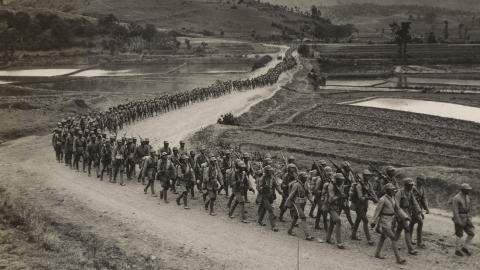The Battle of Midway
We've partnered with Trip Historic, the community-based historic destinations to bring you this series on battles that changed the world.
War: World War II.
Date: 4th – 7th June 1942.
Place: Midway Atoll, Pacific Ocean, around 4,000 kilometres from Japan.
Belligerents: The United States vs Japan.
Described by historian John Keegan as ‘the most stunning and decisive blow in the history of naval warfare,’ the Battle of Midway signalled the death knell of the Imperial Japanese Navy’s first-line carrier strength as well as most of its best-trained fighter pilots and effectively ended Japan’s involvement in the Pacific theatre.
The prelude to battle
Given their location, Japan’s primary goal in World War II was to oust America as a relevant Pacific power and seize territory in East Asia and the southwest Pacific islands. The Imperial Japanese Navy’s surprise attack on the naval base at Pearl Harbour in Hawaii on 7th December 1941 prompted America to declare war on Japan four days later (at the time of attack America was technically neutral and it has since been judged a war crime).
In reality, war between Japan and the US had been bubbling up to a catastrophic crescendo for years.
The Americans had been using the tiny, 66-square kilometre Midway Atoll at the north-western end of the Hawaiian archipelago, 5,200-km west of San Francisco and 4,100-km east of Tokyo, for years. It was perfectly placed for refuelling transpacific flights and it was a convenient stop for the US Navy’s fleet of warships as they traversed the world’s oceans.
As US-Japanese tensions rose in early 1940, this tiny atoll in the middle of nowhere – literally – became second only to Pearl Harbour in its significance to the protection of America’s west coast. Before long, the peaceful Pacific protectorate was covered in airstrips, a manned base and gun emplacements. The Americans were readying themselves for conflict. Perhaps they knew what was coming?
Yamamoto 1, USA 0?
Quite rightly as it turned out, Admiral Isoroku Yamamoto of the Imperial Japanese Navy believed that the attack on Pearl Harbour would draw the limping remains of the US Pacific Fleet out and expose itself into the waiting wake of his far more powerful carrier force and battleships.
In retaliation for Pearl Harbour, the Americans launched a propaganda-driven air attack on Tokyo and other strategic locations on Honshu island called the ‘Doolittle’ raid on April 18th – named for Lieutenant Colonel James Doolittle who planned and led it from the USS Hornet. It was designed not only to debilitate but also to demonstrate to the Japanese that they were vulnerable.
Yamamoto was apoplectic with rage. The raid was an unforgivable insult to his country, primarily because it had threatened the life of Emperor Hirohito. In his mind, this type of affront warranted revenge of the highest order.
As the US Pacific Fleet hobbled out of Hawaii, Vice-Admiral Chuichi Nagumo was ordered to engage and destroy the American carriers that dared contest Japan’s attack on Pearl Harbour and then attack the Midway Atoll, but somehow, the Americans were ready.
Yamamoto was sure he had superior numbers and he was hell-bent on the total destruction of the American fleet. He even went as far as planning an attack on the Alaskan coast which would draw the Americans north, hitting Midway the next day, forcing a US U-turn and back south into an ambush
America’s Bletchley Park
In early 1942, the US Navy’s cryptanalysts at Station HYPO in Hawaii (also known as Fleet Radio Unit Pacific, or FRUPAC) had begun to make headway into the Japanese communication codes and discovered that a Pacific attack was being planned at a location the Japanese codenamed ‘AF’. Much easier than the German Enigma and Lorenz codes, Japan’s Naval General Operational Code used book cyphers and it can be argued that it was the mathematicians and not the soldiers who won the Battle of Midway.
FRUPAC confirmed it was Midway with what must today seem like the most unbelievably simple code-break in history. The Americans at Midway sent out a false message saying they were short of water and before long, the Japanese sent out a message saying ‘AF’ was short of water. Confirmed, and without breaking a sweat.
The Americans figured out the location and date of the attack as well as the Japanese Imperial Navy’s order of battle. Legendary Admiral Chester W Nimitz along with Admirals Frank J Fletcher and Raymond A Spruance were delighted. Nimitz had just been promoted by President Franklin D Roosevelt to Commander-In-Chief, United States Pacific Fleet (CINCPACFLT) and he and his colleagues were itching for a fight.
The best laid plans of mice and men…
Strategically brilliant, Admiral Isoroku Yamamoto was forced to transmit his orders by radio because his ships were so widely dispersed and the Americans were listening, understanding and planning. They were able to recover almost all of the Japanese plan which was very complex but as the battle unfolded, poorly strategised and like much Japanese military planning, unnecessarily over-elaborate.
It relied on what was essentially a first-mover advantage. He sent submarine-launched air reconnaissance to locate the American ships coming out of Pearl Harbour and hoped they’d sail directly into the path of his submarines which would sink them as they responded to his attacks.
What actually happened was that the recon was thwarted by an American warship and the submarine lure arrived late to the party. In addition, the diversionary attack on the Alaskan coast was a waste of time and most importantly, resources. The Americans didn’t even bother responding.
Notwithstanding this miscalculation, Yamamoto’s plan was based on the (incorrect) fact that the Americans only had two carriers left; they were sure they had sunk the USS Yorktown months earlier. In fact, they almost sunk the USS Yorktown. It was repaired in two days at Pearl Harbour. It was ready to play again.
Still, the numbers were heavily weighted towards the Japanese. It had been a full half-century since they had lost a naval battle.
The American Pacific Fleet consisted of Task Force 16, Task Force 17 and the Midway Garrison –
- 3 fleet carriers
- 7 heavy cruisers
- 1 light cruiser
- 15 destroyers
- 233 carrier-based aircraft
- 127 land-based aircraft
- 16 submarines
The Japanese Combined Fleet was made up of the 1st Fleet, 2nd Fleet, 5th Fleet and the 11th Air Fleet –
- 4 fleet carriers
- 2 battleships
- 6 heavy cruisers
- 1 light cruiser
- 14 destroyers
- 248 carrier-based aircraft
- 28 floatplanes
With the odds stacked solidly against him, Nimitz couldn’t hope to win a direct engagement and staked the battle – and some say his reputation and career – on the exploitation of what the brains at HYPO have discovered. He reinforced the air units on Midway and put his carriers to the north-east of the island, waiting patiently for the Japanese to kick off. He was ambushing an ambush.
Such are the nuances of carrier warfare that both Nimitz and Yamamoto knew that the first strike is decisive. Aircraft carriers are full of planes, personnel, fuel and ordnance and a big enough torpedo in the right place can prove fatal. The stakes were very high, not just for this battle but potentially for the entire outcome of the war in the Pacific theatre.
The Battle of Midway
On June 3rd, American Midway-based bombers attacked the Japanese as they approached the island but to little effect and the following morning, Admiral Nagumo launched a bombing raid of 100 planes to take out the island. Initially repelled, they managed to significantly damage the bases on the island but crucially, it remained operational. Just.
Now comes the important bit. The Japanese carriers were then expected to engage with the onrushing Americans and wipe them out but of course, they weren’t onrushing. They were already there, waiting.
Nagumo was rendered indecisive and it was this indecision that cost him and Yamamoto the battle. He had to find the American ships and seize the island but he couldn’t do both. He hesitated when he should have acted.
Fletcher and Spruance, on the other hand, had one job – find and destroy the Japanese carriers. On June 4th they found them and promptly destroyed them. TBD Devastator torpedo-bombers and SBD Dauntless dive-bombers from the USS Yorktown, USS Hornet and USS Enterprise hit the carriers Akagi, Soryu and Kaga, leaving them ablaze and abandoned. The last remaining carrier, Hiryu, twice attempted to take out the USS Yorktown but later the same afternoon, textbook dive-bombing from some of the US Navy’s most experienced fighter pilots off the USS Enterprise relegated it to the bottom of the Pacific Ocean.
The next two days were like a game of chess. As he learned of the attacks, Yamamoto who was still hundreds of miles west with the main battle group reversed course. He knew the game was up. Spruance, fearing a trap, didn’t take the bait although he was criticised for not doing so, effectively allowing the fleeing Japanese to escape although that is merely a footnote in what was a decisive US victory against seemingly insurmountable odds.
The endgame
The Japanese retreated. It was all over for them. Nagumo’s hesitation coupled with Yamamoto’s failed plan forced them to abandon the battle, taking heavy losses.
The final numbers looked like this:
- American losses –
- 1 fleet carrier sunk
- 1 destroyer sunk
- 150 aircraft destroyed
- 307 men killed (including 3 killed as prisoners of the Japanese)
Japanese losses –
- 4 fleet carriers sunk
- 1 heavy cruiser sunk
- 1 heavy cruiser badly damaged
- 248 aircraft destroyed
- 3,057 men killed
- 37 captured
As was common with defeats of such ferocity and embarrassment, (note Hitler after Stalingrad), the Japanese public and even much of the military’s command structure were kept in the dark about the extent of the thrashing. In fact only Emperor Hirohito and the highest Navy command staff knew the full, devastating details.
The Japanese news even went so far as to broadcast a great victory. It was anything but.
The Battle of Midway was viewed as the redefinition of the importance of air superiority, proven by the fact that the Japanese spent the remainder of the war on the defensive. Operational initiative had passed to the Americans from the Japanese. It was the Allies’ first major victory in the Pacific theatre and paved the way for the Guadalcanal landings and the seemingly endless campaign in the Solomon Islands.
Perhaps the most enduring legacy of Midway, notwithstanding Admiral Nimitz’s tactics, is that of the use of brains as well as brawn when fighting a war.
Cryptanalysis was the key. It was all about being one step ahead while keeping your opposition sure you’re one step behind. The British were doing it at Bletchley Park with stunning results thanks to the likes of Alan Turing, Gordon Welchman and Alistair Denniston (the breaking of the Enigma code shortened the war by 2-4 years) and the Americans at HYPO were also coming up trumps.
The efforts of the boffins were reaping rewards in both the Atlantic and Pacific theatres and as we’ve mentioned, it potentially saved millions of lives, both military and civilian.
The history of the Battle of Midway is utterly fascinating, as are the historic sites associated with it and you can read all about the most famous sites of the Second World War on TripHistoric.
















